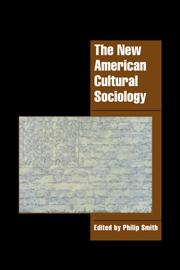Book contents
- Frontmatter
- Contents
- Notes on contributors
- Preface
- The new American cultural sociology: an introduction
- PART I Culture as text and code
- PART II The production and reception of culture
- PART III Culture in action
- 11 Culture and social action
- 12 Culture, structure, agency, and transformation
- 13 Discourse, nuclear power, and collective action
- 14 Moral boundaries, leisure activities, and justifying fun
- 15 Honor and conflict management in corporate life
- 16 The role of cultural capital in school success
- Index
- Title in this Series
11 - Culture and social action
Published online by Cambridge University Press: 18 January 2010
- Frontmatter
- Contents
- Notes on contributors
- Preface
- The new American cultural sociology: an introduction
- PART I Culture as text and code
- PART II The production and reception of culture
- PART III Culture in action
- 11 Culture and social action
- 12 Culture, structure, agency, and transformation
- 13 Discourse, nuclear power, and collective action
- 14 Moral boundaries, leisure activities, and justifying fun
- 15 Honor and conflict management in corporate life
- 16 The role of cultural capital in school success
- Index
- Title in this Series
Summary
The reigning model used to understand culture's effects on action is fundamentally misleading. It assumes that culture shapes action by supplying ultimate ends or values towards which action is directed, thus making values the central causal element of culture. This paper analyzes the conceptual difficulties into which this traditional view of culture leads and offers an alternative model.
Among sociologists and anthropologists, debate has raged for several academic generations over defining the term “culture.” Since the seminal work of Clifford Geertz (1973a), the older definition of culture as the entire way of life of a people, including their technology and material artifacts, or that (associated with the name of Ward Goodenough) as everything one would need to know to become a functioning member of a society, have been displaced in favor of defining culture as the publicly available symbolic forms through which people experience and express meaning (see Keesing 1974). For purposes of this essay, culture consists of such symbolic vehicles of meaning, including beliefs, ritual practices, art forms, and ceremonies, as well as informal cultural practices such as language, gossip, stories, and rituals of daily life. These symbolic forms are the means through which “social processes of sharing, modes of behavior and outlook within [a] community” (Hannerz 1969, p. 184) take place.
The recent resurgence of cultural studies has skirted the causal issues of greatest interest to sociologists. Interpretive approaches drawn from anthropology (Clifford Geertz, Victor Turner, Mary Douglas, and Claude Lévi-Strauss) and literary criticism (Kenneth Burke, Roland Barthes) allow us better to describe the features of cultural products and experiences.
- Type
- Chapter
- Information
- The New American Cultural Sociology , pp. 171 - 187Publisher: Cambridge University PressPrint publication year: 1998
- 8
- Cited by



